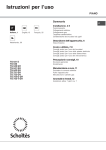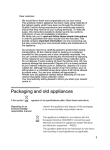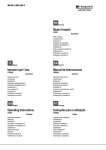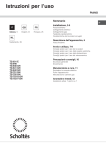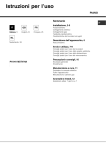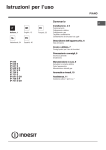Download Mode d`emploi
Transcript
Mode d’emploi CUISINIERE Sommaire FR Français, 1 GB English, 14 NL Nederland, 26 Installation, 2-6 Positionnement et nivellement Raccordement électrique Raccordement gaz Adaptation aux différents types de gaz Caractéristiques techniques Tableau Caractéristiques des brûleurs et des injecteurs Description de l’appareil, 7 Vue d’ensemble Tableau de bord Mise en marche et utilisation, 8-10 I5GGG /NL Utilisation du plan de cuisson Utilisation du four Programmateur électronique Tableau de cuisson Précautions et conseils, 11 Sécurité générale Mise au rebut Economies et respect de l’environnement Nettoyage et entretien, 12 Mise hors tension Nettoyage de l’appareil Entretien robinets gaz Remplacement de l’ampoule d’éclairage du four Assistance Installation FR ! Conservez ce mode d’emploi pour pouvoir le consulter à tout moment. En cas de vente, de cession ou de déménagement, veillez à ce qu’il suive l’appareil. ! Lisez attentivement les instructions : elles contiennent des conseils importants sur l’installation, l’utilisation et la sécurité de votre appareil. pièces voisines (voir figure B) – à condition qu’il ne s’agisse pas de parties communes du bâtiment, de chambres à coucher ou de locaux à risque d’incendie – équipées d’un conduit d’aération avec l’extérieur comme décrit plus haut. Local adjacent Local à ventiler A B ! L’installation de l’appareil doit être effectuée par un professionnel du secteur conformément aux instructions du fabricant. ! N’importe quelle opération de réglage, d’entretien, etc., doit être effectuée après avoir débranché la prise de la cuisinière. Conditions réglementaires d’installation Le raccordement gaz devra être fait par un professionnel qualifié qui assurera la bonne alimentation en gaz et le meilleur réglage de la combustion des brûleurs. Ces opérations d’installation, quoique simples, sont délicates et primordiales pour que votre cuisinière vous rende le meilleur service. L’installation doit être effectuée conformément aux textes réglementaires et règles de l’art en vigueur, notamment: • Arrêté du 2 août 1977. Règles techniques et de sécurité applicables aux installations de gaz combustibles et d’hydro-carbures liquéfiés situées à l’intérieur des bâtiments d’habitation et de leur dépendances. • Norme DTU P45-204. Installations de gaz (anciennement DTU n° 61-1-installations de gaz Avril 1982 + additif n°1 Juillet 1984). • Règlement sanitaire départemental. Aération des locaux L’appareil doit être installé dans des locaux qui sont aérés en permanence, selon les prescriptions des Normes en vigueur dans le pays d’installation. Il est indispensable que la pièce où l’appareil est installé dispose d’une quantité d’air égale à la quantité d’air comburant nécessaire à une bonne combustion du gaz (le flux d’air doit être d’au moins 3 m3/h par kW de puissance installée). Les prises d’air, protégées par des grilles, doivent disposer d’un conduit d’au moins 2 cm2 de section utile et dans une position qui leur évite tout risque d’être bouchées accidentellement, même partiellement (voir figure A). Ces ouvertures doivent être agrandies de 100% (surface minimale 2 cm2) en cas d’appareils dépourvus du dispositif de sécurité de flamme et quand l’afflux de l’air provient de manière indirecte de 2 A Ouverture de ventilation pour l’air comburant Agrandissement de la fissure entre la porte et le sol ! Après une utilisation prolongée de l’appareil, il est conseillé d’ouvrir une fenêtre ou d’augmenter la vitesse de ventilateurs éventuels. Evacuation des fumées de combustion La pièce doit prévoir un système d’évacuation vers l’extérieur des fumées de combustion réalisé au moyen d’une hotte reliée à une cheminée à tirage naturel ou par ventilateur électrique qui entre automatiquement en fonction dès qu’on allume l’appareil (voir figures). Evacuation directement à l’extérieur Evacuation par cheminée ou conduit de fumée ramifié (réservé aux appareils de cuisson) ! Les gaz de pétrole liquéfiés, plus lourds que l’air, se déposent et stagnent dans le bas. Les locaux qui contiennent des bouteilles de G.P.L doivent donc prévoir des ouvertures vers l’extérieur afin de permettre l’évacuation du gaz par le bas en cas de fuites accidentelles. Ne pas installer ou entreposer de bouteilles de GPL, vides ou partiellement pleines, dans des locaux qui se trouvent en sous-sol (caves etc.). Ne gardez dans la pièce que la bouteille que vous êtes en train d’utiliser, loin de sources de chaleur (fours, feux de bois, poêles etc.) qui pourraient amener sa température à plus de 50°C. Positionnement et nivellement ! L’appareil peut être installé à côté de meubles dont la hauteur ne dépasse pas celle du plan de cuisson. ! Assurez-vous que le mur en contact avec la paroi arrière de l’appareil est réalisée en matériel ignifuge résistant à la chaleur (T 90°C). 420 mm. Min. min. 650 mm. with hood min. 700 mm. without hood 420 mm. Min. Pour une installation correcte : • installez cet appareil dans une cuisine, une salle à manger ou un studio (jamais dans une salle de bains); • si le plan de cuisson de la cuisinière dépasse le plan de travail des meubles, ces derniers doivent être placés à au moins 200 mm de l’appareil; • si la cuisinière est installée sous un HOOD élément suspendu, il Min. 600 mm. faut que ce dernier soit placé à au moins 420mm de distance du plan. Il faut prévoir une distance de 700mm si les éléments suspendus sont inflammables (voir figure); • ne placez pas de rideaux derrière la cuisinière ou sur ses côtés à moins de 200 mm de distance; • pour l’installation de hottes, conformez-vous aux instructions de leur notice d’emploi. Nivellement Pour mettre l’appareil bien à plat, vissez les pieds de réglage fournis aux emplacements prévus aux coins à la base de la cuisinière (voir figure). Montage des pieds* par encastrement sous la base. Raccordement électrique Montez sur le câble une prise normalisée pour la charge indiquée sur l’étiquette des caractéristiques (voir tableau des caractéristiques techniques). En cas de raccordement direct au réseau, il faut intercaler entre l’appareil et le réseau un interrupteur à coupure omnipolaire ayant au moins 3 mm d’écartement entre les contacts, dimensionné à la charge et conforme aux normes NFC 15-100 (le fil de terre ne doit pas être interrompu par l’interrupteur). Le câble d’alimentation ne doit atteindre, en aucun point, des températures dépassant de 50°C la température ambiante. FR Avant de procéder au branchement, assurez-vous que : • la prise est bien munie d’une terre conforme à la loi; • la prise est bien apte à supporter la puissance maximale de l’appareil, indiquée sur la plaquette signalétique; • la tension d’alimentation est bien comprise entre les valeurs indiquées sur la plaquette signalétique; • la prise est bien compatible avec la fiche de l’appareil. Si ce n’est pas le cas, remplacez la prise ou la fiche, n’utilisez ni rallonges ni prises multiples. ! Après installation de l’appareil, le câble électrique et la prise de courant doivent être facilement accessibles ! Le câble ne doit être ni plié ni excessivement écrasé. ! Le câble doit être contrôlé périodiquement et ne peut être remplacé que par un technicien agréé. ! Nous déclinons toute responsabilité en cas de non respect des normes énumérées ci-dessus. Raccordement gaz Pour raccorder l’appareil au réseau de distribution du gaz ou à la bouteille de gaz utilisez un tuyau flexible en caoutchouc ou en acier, conformément à la réglementation en vigueur. Assurez-vous auparavant que l’appareil est bien réglé pour le type de gaz d’alimentation utilisé (voir étiquette sur le couvercle : autrement voir ci-dessous). Si l’alimentation s’effectue avec du gaz liquide en bouteille, utilisez des régulateurs de pression conformes à la réglementation en vigueur dans le pays. Pour simplifier le raccordement, l’alimentation du gaz est orientable latéralement* : inversez l’about annelé avec le bouchon de fermeture et remplacez le joint d’étanchéité (fourni avec l’appareil). ! Pour un fonctionnement en toute sécurité, pour un meilleur emploi de l’énergie et une plus longue durée de vie de l’appareil, vérifiez que la pression d’alimentation respecte bien les valeurs indiquées dans le tableau Caractéristiques des brûleurs et des injecteurs (voir ci-dessous). *N’existe que sur certains modèles 3 FR Raccordement gaz par tuyau flexible en caoutchouc Adaptation aux différents types de gaz Assurez-vous que le tuyau est bien conforme aux normes applicables dans le pays d’installation. Le tuyau doit avoir un diamètre intérieur de : 8 mm en cas d’alimentation au gaz liquide; 13 mm en cas d’alimentation au gaz naturel. L’appareil peut être adapté à un type de gaz autre que celui pour le quel il a été conçu (indiqué sur l’étiquette de réglage sur le couvercle). Après avoir effectué le raccordement, assurez-vous que le tuyau : • ne touche en aucun point à des parties pouvant atteindre plus de 50°C; • ne soit pas soumis à traction ou torsion et ne présente pas de pliures ou étranglements; • ne risque pas d’entrer en contact avec des corps tranchants, des arêtes vives, des parties mobiles et ne soit pas écrasé; • puisse être facilement contrôlable sur toute sa longueur pour vérifier son état de conservation; • ait moins de 1500mm de long; • soit bien fixé à ses deux extrémités à l’aide de bagues de serrage conformes à la réglementation en vigueur dans le pays. Remplacement des injecteurs des brûleurs du plan de cuisson: 1.enlevez les grilles du plan de cuisson et sortez les brûleurs de leur logement; 2. dévissez les injecteurs à l’aide d’une clé à tube de 7mm (voir figure), et remplacez-les par les injecteurs adaptés au nouveau type de gaz (voir tableau Caractéristiques des brûleurs et des injecteurs) ; Point de raccordement Bouchon d'isolation SURFACE CHAUDE Point de raccordement Bouchon d'isolation Tuyau Tuyau ! Si une ou plusieurs de ces conditions ne peuvent être remplies ou que la cuisinière est installée dans des conditions de classe 2 – sous-classe 1 (appareil encastré entre deux meubles), il faut utiliser un tuyau flexible en acier (voir ci-dessous). Raccordement gaz par tuyau flexible en acier inox, à paroi continue avec raccords filetés Assurez-vous que le tuyau et les joints sont bien conformes aux normes applicables dans le pays d’installation. Pour installer le tuyau, enlevez l’about annelé équipant l’appareil (le raccord d’entrée du gaz à l’appareil est fileté 1/2 gaz mâle cylindrique). ! Procédez au raccordement de manière à ce que la longueur du tuyau ne dépasse pas 2 mètres d’extension maximale. Veillez à ce que le tuyau ne soit pas écrasé et ne touche en aucun point à des parties mobiles. Adaptation du plan de cuisson 3.remontez les différentes parties en effectuant les opérations dans le sens inverse. Réglage des minima des brûleurs du plan de cuisson : 1.placez le robinet sur la position minimum; 2.enlevez le bouton et tournez la vis de réglage positionnée à l’intérieur ou sur le côté de la tige du robinet jusqu’à obtenir une petite flamme régulière; ! En cas de gaz naturel, il faut dévisser la vis de réglage en tournant dans le sens inverse des aiguilles d’une montre; 3.vérifiez si, en tournant rapidement le robinet du maximum au minimum, le brûleur ne s’éteint pas. ! Les brûleurs du plan de cuisson ne nécessitent pas de réglage de l’air primaire. Adaptation du four Remplacement du brûleur du four: 1. enlever le tiroir chauffe-plats; 2. enlever la protection coulissante A (voir figure); A V Vérification de l’étanchéité Une fois l’installation terminée, vérifiez l’étanchéité de tous les raccords en utilisant une solution savonneuse, n’utilisez jamais de flamme. 4 3. déposer le brûleur du four après avoir enlevé la vis V (voir figure); pour simplifier cette opération, démonter auparavant la porte du four. 4. dévisser l’injecteur du brûleur à l’aide de la clé à tube spéciale pour injecteurs (voir figure) ou d’une clé à tube de 7 mm et le remplacer par l’injecteur adapté au nouveau type de gaz (voir tableau Caractéristiques des brûleurs et des injecteurs). FR Réglage du minimum du brûleur du four à gaz : 1. allumer le brûleur (voir Mise en marche et Utilisation); 2. amener la manette sur la position minimum (MIN) après l’avoir laissée pendant environ 10 minutes sur la position maximum (MAX); 3. enlever le bouton; 4. agir sur la vis de réglage positionnée à l’extérieur de la tige du thermostat (voir figure) jusqu’à obtenir une petite flamme régulière. ! En cas de gaz naturel, il faut dévisser la vis de réglage en tournant dans le sens inverse des aiguilles d’une montre; 5. vérifier si, en tournant rapidement le bouton de la position MAX à la position MIN, ou en ouvrant et fermant rapidement la porte du four, le brûleur ne s’éteint pas. 5 FR Tableau Caractéristiques des brûleurs et des injecteurs Tableau 1 (pour la Hollande) Gaz naturel ! "# $ %&' $ %$ () )* &+ ((& , $ -#., *' )/ )0 0 & 12 1 ' ) )0 *3 5 () ) (& (0( 4# "# ! - ! -2 ! # 6 # * A 15°C et 1013 mbar-gaz sec Naturel G25 P.C.S. = 32,49 MJ/m3 ATTENTION! Le couvercle en verre peut se casser s’il est chauffé. Il faut éteindre tous les brûleurs et les plaques électriques avant de le fermer. S S A R I5GGG /NL &' & ( CARACTERISTIQUES TECHNIQUES Dimensions du 34x39x44 cm Four HxLxP Volume 58 l Dimensions utiles largeur 42 cm du tiroir chauffeprofondeur 44 cm plats hauteur 18 cm adaptables à n'importe quel type de gaz parmi ceux indiqués sur l'étiquette collée à l'intérieur du Brûleurs portillon ou sur la paroi intérieure gauche (visible après avoir sorti le tiroir chauffe-plats). Directives Communautaires 2006/95/EC du 12/12/06 (Basse Tension) et modifications suivantes - 2004/108/EC du 15/12/04 (Compatibilité Electromagnétique) et modifications suivantes 90/396/EEC du 29/06/90 (Gaz) et modifications suivantes 93/68/EEC du 22/07/93 et modifications suivantes 2002/96/CE 1275/2008 (Stand-by/ Off mode) ÉTIQUETTE ÉNERGIE Directive de l’UE n°65/2014 intégrant la et ÉCOCONCEPTION Directive 2010/30/UE. Règlement n°66/2014 de l’UE intégrant la Directive 2009/125/EC. Norme EN 15181 Norme EN 30-2-1 6 Description de l’appareil Vue d’ensemble FR Le couvercle Brûleur à gaz Grille du plan de cuisson Tableau de bord Support GRILLE Support LECHEFRITE Pied de réglage Plateau du plan de cuisson GLISSIERES de coulissement niveau 5 niveau 4 niveau 3 niveau 2 niveau 1 Pied de réglage Tableau de bord Manette FOUR Manettes BRÛLEURS du plan de cuisson *N’existe que sur certains modèles 7 Mise en marche et utilisation FR Utilisation du plan de cuisson Allumage des brûleurs Un petit cercle plein près de chaque manette BRULEUR indique le brûleur associé à ce dernier. Pour allumer un brûleur du plan de cuisson : 1. approchez une flamme ou un allume-gaz ; 2. poussez sur le manette du BRULEUR tout en le tournant dans le sens inverse des aiguilles d’une montre jusqu’au symbole grande flamme . 3. pour régler la puissance de la flamme souhaitée, tournez le manette BRULEUR dans le sens inverse des aiguilles d’une montre : sur la position minimum , sur la position maximum ou sur une position intermédiaire. Si l’appareil est équipé d’un allumage électronique* (C) il X suffit de pousser et de tourner en même temps dans le sens inverse des aiguilles d’une montre le C bouton BRULEUR sur le symbole petite flamme, jusqu’à l’allumage. Il peut arriver que le brûleur s’éteigne dès que vous lâchez le bouton. Dans ce cas, essayez à nouveau en poussant plus longtemps sur le bouton. ! En cas d’extinction accidentelle des flammes, éteignez le brûleur et attendez au moins 1 minute avant de tenter de rallumer. Si l’appareil est équipé d’un dispositif de sécurité* (X) de flamme, poussez sur le manette BRULEUR pendant 2-3 secondes pour garder la flamme allumée et pour activer le dispositif. Pour éteindre le brûleur, tournez le bouton jusqu’à la position d’arrêt . Conseils pratiques pour l’utilisation des brûleurs Pour un meilleur rendement des brûleurs et une moindre consommation de gaz, utilisez des casseroles à fond plat, munies de couvercle et d’un diamètre adapté au brûleur : Brûleur ø Diamètre récipients (cm) $$ &0H&3 , 5$, 3H& 121 H0 Pour distinguer le type de brûleur reportez-vous aux dessins figurant dans le paragraphe "Caractéristiques des brûleurs et des injecteurs" Utilisation du four ! Lors de son premier allumage, faites fonctionner le four à vide, porte fermée, pendant au moins une heure en réglant la température à son maximum. Puis éteignez-le, ouvrez la porte et aérez la pièce. L’odeur qui se dégage est due à l’évaporation des produits utilisés pour protéger le four. ! Avant toute utilisation, vous devez impérativement enlever les films plastiques situés sur les côtés de l’appareil ! Ne posez jamais d’objets à même la sole du four, vous pourriez abîmer l’émail. N’utilisez la position 1 du four qu’en cas de cuissons au tournebroche. Allumage du four F Pour allumer le brûleur du four, approchez une flamme ou un allume-gaz de l’orifice F (voir figure), poussez sur le bouton FOUR et tournez-le en même temps dans le sens inverse des aiguilles d’une montre jusqu’à la position MAX. ! Le four étant équipé d’un dispositif de sécurité de flamme, il faut pousser sur le bouton du FOUR pendant environ 6 secondes. ! En cas d’extinction accidentelle de flamme, éteignez le brûleur et attendez au moins 1 minute avant de tenter de rallumer. Pour éteindre le brûleur, tourner le bouton jusqu’à la position d’arrêt •. Réglage de la température Pour sélectionner la température de cuisson souhaitée, tournez le bouton FOUR dans le sens inverse des aiguilles d’une montre. Les températures sont indiquées sur le tableau de bord et vont d’un MIN (140°C) à un MAX (250°C). Une fois que la température est atteinte dans le four, un thermostat la maintient constante au degré prêt. *N’existe que sur certains modèles 8 Eclairage du four FR Pour le brancher, amener le bouton FOUR sur une position autre que la position "0". Il reste allumé tant que le four ou le gril est en marche. Niche inférieure Une niche ménagée audessous du four peut être utilisée pour entreposer des accessoires ou des casseroles. Pour ouvrir le volet, faites-le pivoter vers le bas (voir figure). ! Ne stockez pas de matériel inflammable dans la niche du bas. Les modèles de cuisinière à gaz sont équipés d’une protection coulissante A qui sert à protéger la niche du bas contre la chaleur produite par le brûleur (voir figure). A S Pour enlever la protection coulissante “A”, dévissez la vis S (voir figure). Pour la remonter, fixez-la à l’aide de la vis S. ! Avant toute utilisation du four, assurez-vous que la protection coulissante est fixée correctement. 9 FR Tableau de cuisson Poids (Kg) Niveau enfournement Préchauffage (minutes) Température préconisée (°C) Durée cuisson (minutes) Pâtes Lasagnes Cannelloni Gratin de pâtes 2.5 2.5 2.5 2 2 2 200-210 200 200 10 10 10 75-85 50-60 50-60 Viande Veau Poulet Canard Lapin Porc Agneau 1.5 1.5 1.8 2.0 2.1 1.8 3 3 3 3 3 3 200-210 210-220 200 200 200 200 10 10 10 10 10 10 95-100 90-100 100-110 70-80 70-80 100-105 Poisson Maquereaux Denté Truite en papillote 1.1 1.5 1.0 3 3 3 180-200 180-200 180-200 10 10 10 45-50 45-55 45-50 Pizza Napolitaine 1.0 4 210-220 15 20-25 Gâteaux Biscuits Tarte Tartes salées Gâteaux levés 0.5 1.1 1.0 1.0 4 4 4 4 180 180 180 170 15 15 15 15 25-35 40-45 50-55 40-45 Aliments Précautions et conseils ! Cet appareil a été conçu et fabriqué conformément aux normes internationales de sécurité. Ces conseils sont fournis pour des raisons de sécurité et doivent être lus attentivement. • Sécurité générale • Cet appareil a été conçu pour un usage familial, de type non professionnel. • Cet appareil ne doit pas être installé en extérieur, même dans un endroit abrité, il est en effet très dangereux de le laisser exposé à la pluie et aux orages. • Ne touchez pas à l’appareil si vous êtes pieds nus ou si vous avez les mains ou les pieds mouillés ou humides. Cet appareil qui sert à cuire des aliments ne doit être utilisé que par des adultes conformément aux instructions du mode d'emploi. Toute autre utilisation (comme par exemple le chauffage d'une 10 • • • • • pièce) est impropre et donc dangereux. Le fabricant décline toute responsabilité en cas de dommages provoqués par un usage impropre ou erroné. Cette notice concerne un appareil classe 1 (libre pose) ou classe 2 - sous-classe 1 (encastré entre deux meubles). Eloignez les enfants. Evitez que le cordon d’alimentation d’autres petits électroménagers touche à des parties chaudes de l’appareil. Les orifices ou les fentes d’aération ou d’évacuation de la chaleur ne doivent pas être bouchés Evitez de fermer le couvercle en verre du plan de cuisson (équipant certains modèles) si les brûleurs sont allumés ou encore chauds. Utilisez toujours des gants de protection pour enfourner ou sortir des plats du four. Précautions et conseils • N’utilisez pas de solutions inflammables (alcool, essence..) à proximité de l’appareil lorsqu’il est en marche. • Ne stockez pas de matériel inflammable dans la niche de rangement du bas ou dans le four : si l’appareil était par inadvertance mis en marche, il pourrait prendre feu. • Lorsque l’appareil n’est pas utilisé, assurez-vous que les boutons sont bien sur la position et que le robinet du gaz est fermé. • Ne tirez surtout pas sur le câble pour débrancher la fiche de la prise de courant. • N’effectuez aucune opération de nettoyage ou d’entretien sans avoir auparavant débranché la fiche de la prise de courant. • En cas de panne, n’essayez en aucun cas d’accéder aux mécanismes internes pour tenter de réparer l’appareil. Faites appel au service d’assistance. • Ne posez pas d’objets lourds sur la porte du four ouverte. • Cet appareil n’est pas prévu pour être utilisé par des personnes (y compris les enfants) dont les capacités physiques, sensorielles ou mentales sont réduites, ou des personnes dénuées d’expérience ou de connaissance, sauf si elles ont pu bénéficier, par l’intermédiaire d’une personne responsable de leur sécurité, d’une surveillance ou d’instructions préalables concernant d’utilisation de l’appareil. • S'assurer que les enfants ne jouent pas avec l'appareil. • Si la cuisinière est installée sur un socle, prenez les précautions qui s'imposent pour que l'appareil ne tombe pas de ce socle. • Cet appareil n’est pas prévu pour être utilisé par des personnes (y compris les enfants) dont les capacités physiques, sensorielles ou mentales sont réduites, ou des personnes dénuées d’expérience ou de connaissance, sauf si elles ont pu bénéficier, par l’intermédiaire d’une personne responsable de leur sécurité, d’une surveillance ou d’instructions préalables concernant d’utilisation de l’appareil. • S'assurer que les enfants ne jouent pas avec l'appareil. Mise au rebut • Mise au rebut du matériel d’emballage : conformezvous aux réglementations locales, les emballages pourront ainsi être recyclés. • La directive européenne 2002/96/CE relative aux déchets d’équipements électriques et électroniques (DEEE), prévoit que les électroménagers ne peuvent pas être traités comme des déchets solides urbains normaux. Les appareils usagés doivent faire l’objet d’une collecte séparée pour optimiser le taux de récupération et de recyclage des matériaux qui les composent et empêcher tout danger pour la santé et pour l’environnement. Le symbole de la poubelle barrée sur roues est appliqué sur tous les produits pour rappeler qu’ils font l’objet d’une collecte sélective. Les électroménagers usagés pourront être remis au service de collecte public, déposés dans les déchetteries communales prévues à cet effet ou, si la loi du pays le prévoit, repris par les revendeurs lors de l’achat d’un nouvel appareil de même type. Tous les principaux fabricants d’électroménagers s’appliquent à créer et gérer des systèmes de collecte et d’élimination des appareils usagés. FR Economies et respect de l’environnement • Pour faire des économies d’électricité, utilisez autant que possible votre four pendant les heures creuses. • Évitez, dans la mesure du possible, de préchauffer le four et veuillez toujours le remplir. Ouvrez le moins possible la porte de votre four, car chaque ouverture laisse échapper la chaleur. Pour faire des économies considérables d’énergie, éteignez le four cinq à dix minutes avant la fin du temps de cuisson programmé et utilisez la chaleur dégagée par le four. • Gardez les joints propres et bien rangés afin d’éviter toute perte d’énergie par la porte. • Si vous avez souscrit un plan tarifaire particulier auprès de la compagnie d’électricité, vous pouvez économiser en faisant fonctionner votre appareil lorsque l’énergie vous revient moins chère. • La base de votre casserole ou de votre poêle doit couvrir la plaque chauffante. Si elle est plus petite, une quantité précieuse d’énergie sera perdue et les casseroles qui débordent laisseront des résidus incrustés qui peuvent être difficiles à enlever. • Faites cuire vos aliments dans des casseroles ou des poêles à couvercle et utilisez le moins d’eau possible. Faire cuire les aliments dans des casseroles ouvertes augmente considérablement la consommation d’énergie. • Utilisez exclusivement des casseroles et poêles à fond plat. • Si vous cuisinez un aliment qui nécessite beaucoup de temps, il est préférable d’utiliser un autocuiseur qui est deux fois plus rapide et économise un tiers de l’énergie. 11 Nettoyage et entretien FR Mise hors tension Avant toute opération de nettoyage ou d’entretien coupez l’alimentation électrique de l’appareil. Nettoyage de l’appareil ! Ne pas utiliser de détergents abrasifs ou corrosifs, tels que détacheurs et dérouilleurs, poudres à récurer et éponges à surface abrasive : ils risquent de rayer irrémédiablement la surface. ! Ne nettojez jamais l’appareil avec des nettoyeurs vapeur ou haute pression. • Pour un entretien courant, passer une éponge humide sur la surface de la table et essuyer avec du papier essuie-tout. • Nettoyez l’extérieur émaillé ou inox et les joints en caoutchouc à l’aide d’une éponge imbibée d’eau tiède additionnée de savon neutre Si les taches sont difficiles à enlever, utilisez des produits spéciaux. Rincez abondamment et essuyez soigneusement. N’utilisez ni poudres abrasives ni produits corrosifs. • Les grilles, les chapeaux, les couronnes et les brûleurs du plan de cuisson sont amovibles et peuvent ainsi être nettoyés plus facilement. Lavez-les à l’eau chaude additionnée d’un détergent non abrasif, éliminez toute incrustation et attendez qu’ils soient parfaitement secs avant de les remonter. • Dans le cas de tables équipées d'allumage automatique, nettoyer fréquemment et soigneusement l'extrémité des dispositifs d'allumage électronique instantané et vérifier que les orifices de sortie du gaz ne sont pas bouchés. • Nettoyez l’enceinte du four après toute utilisation, quand il est encore tiède. Utilisez de l’eau chaude et du détergent, rincez et séchez avec un chiffon doux. Evitez tout produit abrasif. • Nettoyer la vitre de la porte avec des produits non abrasifs et des éponges non grattantes, essuyer ensuite avec un chiffon doux. Ne pas utiliser de matériaux abrasifs ou de racloirs métalliques aiguisés qui risquent de rayer la surface et de briser le verre. • Les accessoires peuvent être lavés comme de la vaisselle courante y compris en lave-vaisselle. • Des taches peuvent se former sur l'acier inox si ce dernier reste trop longtemps au contact d'une eau très calcaire ou de détergents agressifs (contenant du phosphore). Il est conseillé de rincer abondamment et d'essuyer après le nettoyage. Mieux vaut essuyer aussitôt tout débordement d'eau. 12 Le couvercle Pour le nettoyage des modèles équipés de couvercle en verre, utilisez de l’eau tiède. Evitez tout produit abrasif. Vous pouvez déposer le couvercle pour simplifier le nettoyage de la zone arrière du plan de cuisson : ouvrez-le complètement et tirez vers le haut (voir figure). ! Evitez de refermer le couvercle si les brûleurs sont allumés ou encore chauds. Contrôler les joints du four Contrôlez périodiquement l’état du joint autour de la porte du four. S’il est abîmé, adressez-vous au service après-vente le plus proche de votre domicile. Mieux vaut ne pas utiliser le four tant qu’il n’est pas réparé. Entretien robinets gaz Il peut arriver qu’au bout d’un certain temps, un robinet se bloque ou tourne difficilement. Il faut alors le remplacer. ! Cette opération doit être effectuée par un technicien agréé par le fabricant. Remplacement de l’ampoule d’éclairage du four 1. Débranchez le four, enlevez le couvercle en verre du logement de la lampe (voir figure). 2. Dévissez l’ampoule et remplacez-la par une autre de même type : tension 230 V, puissance 25 W, culot E 14. 3.Remontez le couvercle et rebranchez le four au réseau électrique. Assistance Indiquez-lui : • le modèle de votre appareil (Mod.) • son numéro de série (S/N) Ces informations figurent sur la plaquette signalétique apposée sur votre appareil et/ou sur son emballage. Démontage et remontage de la porte du four : 1. Ouvrir la porte 2. Faire pivoter à l'arrière les crochets des charnières de la porte du four (voir photo) FR 6. Remonter la vitre. ATTENTION! Four ne doit pas être utilisé avec intérieure verre de portière enlevé! ATTENTION! Lors du remontage de la porte intérieure verre insérer le panneau de verre correctement, de sorte que le texte écrit sur le panneau n’est pas inversée et peuvent être facilement lisibles. 7. Remonter le profil, un clic signale si la pièce est positionnée comme il faut. 8. Ouvrir la porte complètement. 9. Refermer les cavaliers (voir photo). 3. Refermer la porte jusqu'à l'arrêt du crochet (la porte restera ouverte à 40° environ) (voir photo) 40° 4. Appuyer sur les deux boutons placés sur le profil supérieur et retirer le profil (voir photo) 10.Il est à présent possible de fermer complètement la porte, pour faire fonctionner le four. 5. Retirer la plaque de verre, procéder au nettoyage comme indiqué au chapitre : « Nettoyage et entretien ». 13 Operating Instructions COOKER FR Français, 1 GB English, 14 NL Nederland, 24 Contents Installation, 15-18 Positioning and levelling Electrical connections Gas connection Adapting to different types of gas Technical data Table of burner and nozzle specifications Description of the appliance, 19 Overall view Control panel Start-up and use, 20-22 I5GGG /NL Using the hob Using the oven Analogue timer Oven cooking advice table Precautions and tips, 23 General safety Disposal Respecting and conserving the environment Maintenance and care, 24 Switching the appliance off Cleaning the appliance Gas tap maintenance Replacing the oven light bulb Assistance Installation ! Before operating your new appliance please read this instruction booklet carefully. It contains important information concerning the safe installation and operation of the appliance. ! Please keep these operating instructions for future reference. Make sure that the instructions are kept with the appliance if it is sold, given away or moved. GB Disposing of combustion fumes The disposal of combustion fumes should be guaranteed using a hood connected to a safe and efficient natural suction chimney, or using an electric fan that begins to operate automatically every time the appliance is switched on (see figure). ! The appliance must be installed by a qualified professional according to the instructions provided. ! Any necessary adjustment or maintenance must be performed after the cooker has been disconnected from the electricity supply. Room ventilation The appliance may only be installed in permanentlyventilated rooms, according to current national legislation. The room in which the appliance is installed must be ventilated adequately so as to provide as much air as is needed by the normal gas combustion process (the flow of air must not be lower than 2 m3/h per kW of installed power). The air inlets, protected by grilles, should have a duct with an inner cross section of at least 100 cm2 and should be positioned so that they are not liable to even partial obstruction (see figure A). These inlets should be enlarged by 100% - with a minimum of 200 cm2 - whenever the surface of the hob is not equipped with a flame failure safety device. When the flow of air is provided in an indirect manner from adjacent rooms (see figure B), provided that these are not communal parts of a building, areas with increased fire hazards or bedrooms, the inlets should be fitted with a ventilation duct leading outside as described above. Adjacent room A B Room requiring ventilation Fumes channelled straight outside Fumes channelled through a chimney or branched flue system reserved for cooking appliances) ! The liquefied petroleum gases are heavier than air and collect by the floor, therefore all rooms containing LPG cylinders must have openings leading outside so that any leaked gas can escape easily. LPG cylinders, therefore, whether partially or completely full, must not be installed or stored in rooms or storage areas that are below ground level (cellars, etc.). Only the cylinder being used should be stored in the room; this should also be kept well away from sources of heat (ovens, chimneys, stoves) that may cause the temperature of the cylinder to rise above 50°C. Positioning and levelling ! It is possible to install the appliance alongside cupboards whose height does not exceed that of the hob surface. ! Make sure that the wall in contact with the back of the appliance is made from a non-flammable, heatresistant material (T 90°C). A Ventilation opening for comburent air Increase in the gap between the door and the flooring ! After prolonged use of the appliance, it is advisable to open a window or increase the speed of any fans used. To install the appliance correctly: • Place it in the kitchen, dining room or the bed-sit (not in the bathroom). • If the top of the hob is higher than the cupboards, the appliance must be installed at least 200 mm away from them. • If the cooker is installed underneath a wall cabinet, there must be a minimum distance of 420 mm between this cabinet and the top of the hob. This distance should be increased to 700 mm if the wall cabinets are flammable (see figure). 15 GB 420 mm. 420 mm. Min. 600 mm. Min. Min. min. 650 mm. with hood min. 700 mm. without hood HOOD • Do not position blinds behind the cooker or less than 200 mm away from its sides. • Any hoods must be installed according to the instructions listed in the relevant operating manual. Levelling If it is necessary to level the appliance, screw the adjustable feet into the places provided on each corner of the base of the cooker (see figure). The legs* fit into the slots on the underside of the base of the cooker. Electrical connection Install a standardised plug corresponding to the load indicated on the appliance data plate (see Technical data table). The appliance must be directly connected to the mains using an omnipolar circuit-breaker with a minimum contact opening of 3 mm installed between the appliance and the mains. The circuit-breaker must be suitable for the charge indicated and must comply with NFC 15-100 regulations (the earthing wire must not be interrupted by the circuit-breaker). The supply cable must be positioned so that it does not come into contact with temperatures higher than 50°C at any point. Before connecting the appliance to the power supply, make sure that: • The appliance is earthed and the plug is compliant with the law. • The socket can withstand the maximum power of the appliance, which is indicated by the data plate. • The voltage is in the range between the values indicated on the data plate. • The socket is compatible with the plug of the appliance. If the socket is incompatible with the plug, ask an authorised technician to replace it. Do not use extension cords or multiple sockets. * Only available in certain models 16 ! Once the appliance has been installed, the power supply cable and the electrical socket must be easily accessible. ! The cable must not be bent or compressed. ! The cable must be checked regularly and replaced by authorised technicians only. ! The manufacturer declines any liability should these safety measures not be observed. Gas connection Connection to the gas network or to the gas cylinder may be carried out using a flexible rubber or steel hose, in accordance with current national legislation and after making sure that the appliance is suited to the type of gas with which it will be supplied (see the rating sticker on the cover: if this is not the case see below). When using liquid gas from a cylinder, install a pressure regulator which complies with current national regulations. To make connection easier, the gas supply may be turned sideways*: reverse the position of the hose holder with that of the cap and replace the gasket that is supplied with the appliance. ! Check that the pressure of the gas supply is consistent with the values indicated in the Table of burner and nozzle specifications (see below). This will ensure the safe operation and durability of your appliance while maintaining efficient energy consumption. Gas connection using a flexible rubber hose Make sure that the hose complies with current national legislation. The internal diameter of the hose must measure: 8 mm for liquid gas supply; 13 mm for methane gas supply. Once the connection has been performed, make sure that the hose: • Does not come into contact with any parts that reach temperatures of over 50°C. • Is not subject to any pulling or twisting forces and that it is not kinked or bent. • Does not come into contact with blades, sharp corners or moving parts and that it is not compressed. • Is easy to inspect along its whole length so that its condition may be checked. • Is shorter than 1500 mm. • Fits firmly into place at both ends, where it will be fixed using clamps that comply with current regulations. ! If one or more of these conditions is not fulfilled or if the cooker must be installed according to the conditions listed for class 2 - subclass 1 appliances (installed between two cupboards), the flexible steel hose must be used instead (see below). Connecting a flexible jointless stainless steel pipe to a threaded attachment Make sure that the hose and gaskets comply with current national legislation. To begin using the hose, remove the hose holder on the appliance (the gas supply inlet on the appliance is a cylindrical threaded 1/2 gas male attachment). ! Perform the connection in such a way that the hose length does not exceed a maximum of 2 metres, making sure that the hose is not compressed and does not come into contact with moving parts. Checking the connection for leaks When the installation process is complete, check the hose fittings for leaks using a soapy solution. Never use a flame. Adapting to different types of gas It is possible to adapt the appliance to a type of gas other than the default type (this is indicated on the rating label on the cover). Adapting the hob Replacing the nozzles for the hob burners: 1. Remove the hob grids and slide the burners off their seats. 2. Unscrew the nozzles using a 7 mm socket spanner (see figure), and replace them with nozzles suited to the new type of gas(see Burner and nozzle specifications table). 3. Replace all the components by following the above instructions in reverse. GB Adjusting the hob burners’ minimum setting: 1. Turn the tap to the minimum position. 2. Remove the knob and adjust the regulatory screw, which is positioned inside or next to the tap pin, until the flame is small but steady. ! If the appliance is connected to a liquid gas supply, the regulatory screw must be fastened as tightly as possible. 3. While the burner is alight, quickly change the position of the knob from minimum to maximum and vice versa several times, checking that the flame is not extinguished. ! The hob burners do not require primary air adjustment. Adapting the oven Replacing the oven burner nozzle: 1. Remove the oven compartment. 2. Slide out the protection panel A (see diagram). A V 3. Remove the oven burner after unscrewing the screws V (see figure). The whole operation will be made easier if the oven door is removed. 4. Unscrew the nozzle using a special nozzle socket spanner (see figure) or with a 7 mm socket spanner, and replace it with a new nozzle that is suited to the new type of gas (see Burner and nozzle specifications table). 17 Adjusting the gas oven burner’s minimum setting: GB TECHNICAL DATA Oven dimensions (HxWxD) Volume Useful measurements relating to the oven compartment Power supply voltage and frequency 1. Light the burner (see Start-up and Use). 2. Turn the knob to the minimum position (MIN) after it has been in the maximum position (MAX) for approximately 10 minutes. 3. Remove the knob. 4. Tighten or loosen the adjustment screws on the outside of the thermostat pin (see figure) until the flame is small but steady. ! If the appliance is connected to liquid gas, the adjustment screw must be fastened as tightly as possible. 58 l width 42 cm depth 44 cm height 18 cm see data plate may be adapted for use with any type of gas shown on the data plate, which is located inside the flap or, after the oven compartment has been opened, on the left-hand wall inside the oven. EC Directives: 2006/95/EC dated 12/12/06 (Low Voltage) and subsequent amendments 2004/108/EC dated 15/12/04 (Electromagnetic Compatibility) and subsequent amendments 2009/142/EC dated 30/11/09 (Gas) and subsequent amendments - 93/68/EEC dated 22/07/93 and subsequent amendments - 2002/96/EC. 1275/2008 (Stand-by/ Off mode) Burners 5. Turn the knob from the MAX position to the MIN position quickly or open and shut the oven door, making sure that the burner is not extinguished. WARNING! The glass lid can break in if it is heated up. Turn off all the burners and the electric plates before closing the lid. *Applies to the models with glass cover only. 34x39x44 cm Regulation (EU) No 65/2014 supplementing Directive 2010/30/EU. Regulation (EU) No 66/2014 implementing Directive 2009/125/EC. Standard EN 30-2-1 Standard EN 15181. ENERGY LABEL and ECODESIGN Table of burner and nozzle specifications Table 1 Burner Fast (Large)(R) Semi Fast (Medium)(S) Auxiliary (Small)(A) Oven Supply Pressures * 18 Diameter (mm) Thermal Power kW (p.c.s.*) Nominal Reduced Natural Gas Nozzle Flow* 1/100 l/h (mm) G25 100 3.00 0.7 128 332 75 1.90 0.4 104 210 51 1.00 0.4 76 111 3.10 1.0 Nominal (mbar) Minimum (mbar) Maximum (mbar) 132 343 - A 15°C et 1013 mbar-gas sec Natural G25 P.C.S. = 32,49 MJ/m3 25 20 30 S S A R I5GGG /NL Description of the appliance Overall view GB Control panel OVEN control knob Hob BURNER control knobs * Only available in certain models. 19 Start-up and use Using the hob GB Lighting the burners For each BURNER knob there is a complete ring showing the strength of the flame for the relevant burner. To light one of the burners on the hob: 1. Bring a flame or gas lighter close to the burner. 2. Press the BURNER knob and turn it in an anticlockwise direction so that it is pointing to the maximum flame setting . 3. Adjust the intensity of the flame to the desired level by turning the BURNER knob in an anticlockwise direction. This may be the minimum setting , the maximum setting or any position in between the two. If the appliance is fitted with an electronic lighting X device* (C), simply press the BURNER knob and turn it in an anticlockwise direction so that it is pointing to the maximum C flame setting, until the burner is lit. The burner may be extinguished when the knob is released. If this occurs, repeat the operation, holding the knob down for a longer period of time. Burner ø Cookware diameter (cm) To identify the type of burner, please refer to the diagrams contained in the “Burner and nozzle specifications”. Using the oven ! The first time you use your appliance, heat the empty oven with its door closed at its maximum temperature for at least half an hour. Ensure that the room is well ventilated before switching the oven off and opening the oven door. The appliance may emit a slightly unpleasant odour caused by protective substances used during the manufacturing process burning away. ! Before operating the product, remove all plastic film from the sides of the appliance. ! Never put objects directly on the bottom of the oven; this will avoid the enamel coating being damaged. Only use position 1 in the oven when cooking with the rotisserie spit. Lighting the oven ! If the flame is accidentally extinguished, switch off the burner and wait for at least 1 minute before attempting to relight it. If the appliance is equipped with a flame failure safety device* (X), press and hold the BURNER knob for approximately 2-3 seconds to keep the flame alight and to activate the device. To switch the burner off, turn the knob until it reaches the stop position •. If, after 15 seconds, the burner is still not alight, release the knob, open the oven door and wait for at least 1 minute before trying to light it again. Practical advice on using the burners ! The oven is fitted with a safety device and it is therefore necessary to hold the OVEN control knob down for approximately 6 seconds. For the burners to work in the most efficient way possible and to save on the amount of gas consumed, it is recommended that only pans that have a lid and a flat base are used. They should also be suited to the size of the burner. * Only available in certain models. 20 F To light the oven burner, bring a flame or gas lighter close to opening F (see figure) and press the OVEN control knob while turning it in an anticlockwise direction until it reaches the MAX position. ! If the flame is accidentally extinguished, switch off the burner and wait for at least 1 minute before attempting to relight the oven. Adjusting the temperature GB To set the desired cooking temperature, turn the OVEN control knob in an anticlockwise direction. Temperatures are displayed on the control panel and may vary between MIN (140°C) and MAX (250°C). Once the set temperature has been reached, the oven will keep it constant by using its thermostat. Oven light This is switched on by turning the OVEN knob to any position other than “0”. It remains lit as long as the oven is operating. Lower compartment There is a compartment underneath the oven that may be used to store oven accessories or deep dishes. To open the door pull it downwards (see figure). ! The internal surfaces of the compartment (where present) may become hot. ! Do not place flammable materials in the lower oven compartment. In gas cooker models, there is a sliding protection layer A that shields the lower compartment from the heat generated by the burner (see figure). A S To remove the sliding protection remove the screw S (see figure). To replace it, lock it in place with the screw S. ! Before using the oven make sure that the sliding protection is fixed correctly. 21 Oven cooking advice table GB Foods Pasta Lasagne Cannelloni Gratin dishes Meat Veal Chicken Duck Rabbit Pork Lamb Fish Mackerel Dentex Trout baked in foil Pizza Neapolitan-style Pies Biscuits Tart Savoury pies Leavened cakes Weight (in kg) Rack position Preheating time (min) Recommended Temperature (°C) Cooking time (minutes) 2.5 2.5 2.5 3 3 3 10 10 10 200-210 200 200 75-85 50-60 50-60 1.7 1.5 1.8 2 2.1 1.8 3 3 3 3 3 3 10 10 10 10 10 10 200-210 210-220 200 200 200 200 95-100 90-100 100-110 70-80 70-80 100-105 1.1 1.5 1 3 3 3 10 10 10 180-200 180-200 180-200 45-50 45-55 45-50 1 4 15 210-220 20-25 0.5 1.1 1 1 4 4 4 4 15 15 15 15 180 180 180 170 25-35 40-45 50-55 40-45 Precautions and tips ! This appliance has been designed and manufactured in compliance with international safety standards. The following warnings are provided for safety reasons and must be read carefully. General safety • These instructions are only valid for the countries whose symbols appear in the manual and on the serial number plate. • The appliance was designed for domestic use inside the home and is not intended for commercial or industrial use. • The appliance must not be installed outdoors, even in covered areas. It is extremely dangerous to leave the appliance exposed to rain and storms. • Do not touch the appliance with bare feet or with wet or damp hands and feet. • The appliance must be used by adults only for the preparation of food, in accordance with the instructions outlined in this booklet. Any other use of the appliance (e.g. for heating the room) constitutes improper use and is dangerous. The manufacturer may not be held liable for any damage resulting from improper, incorrect and unreasonable use of the appliance. 22 • The instruction booklet accompanies a class 1 (insulated) or class 2 - subclass 1 (recessed between 2 cupboards) appliance. • Keep children away from the oven. • Make sure that the power supply cables of other electrical appliances do not come into contact with the hot parts of the oven. • The openings used for the ventilation and dispersion of heat must never be covered. • Do not close the glass hob cover (selected models only) when the burners are alight or when they are still hot. • Always use oven gloves when placing cookware in the oven or when removing it. • Do not use flammable liquids (alcohol, petrol, etc...) near the appliance while it is in use. Precautions and tips • Do not place flammable material in the lower storage compartment or in the oven itself. If the appliance is switched on accidentally, it could catch fire. • Always make sure the knobs are in the • position and that the gas tap is closed when the appliance is not in use. • When unplugging the appliance, always pull the plug from the mains socket; do not pull on the cable. • Never perform any cleaning or maintenance work without having disconnected the appliance from the electricity mains. • If the appliance breaks down, under no circumstances should you attempt to repair the appliance yourself. Repairs carried out by inexperienced persons may cause injury or further malfunctioning of the appliance. Contact Assistance. • Do not rest heavy objects on the open oven door. • If the cooker is placed on a pedestal, take the necessary precautions to prevent the same from sliding off the pedestal itself. • The appliance should not be operated by people (including children) with reduced physical, sensory or mental capacities, by inexperienced individuals or by anyone who is not familiar with the product. These individuals should, at the very least, be supervised by someone who assumes responsibility for their safety or receive preliminary instructions relating to the operation of the appliance. • Do not let children play with the appliance. Disposal Respecting and conserving the environment • You can help to reduce the peak load of the electricity supply network companies by using the oven in the hours between late afternoon and the early hours of the morning. • Whenever possible, avoid pre-heating the oven and always try to fill it. Open the oven door as little as possible because heat is lost every time it is opened. To save a substantial amount of energy, simply switch off the oven 5 to 10 minutes before the end of your planned cooking time and use the heat the oven continues to generate. • Keep gaskets clean and tidy to prevent any door energy losses • If you have a timed tariff electricity contract, the “delay cooking” option will make it easier to save money by moving operation to cheaper time periods. • The base of your pot or pan should cover the hot plate. If it is smaller, precious energy will be wasted and pots that boil over leave encrusted remains that can be difficult to remove. • Cook your food in closed pots or pans with well-fitting lids and use as little water as possible. Cooking with the lid off will greatly increase energy consumption • Use purely flat pots and pans • If you are cooking something that takes a long time, it's worth using a pressure cooker, which is twice as fast and saves a third of the energy. • When disposing of packaging material: observe local legislation so that the packaging may be reused. • The European Directive 2002/96/EC relating to Waste Electrical and Electronic Equipment (WEEE) states that household appliances should not be disposed of using the normal solid urban waste cycle. Exhausted appliances should be collected separately in order to optimise the cost of re-using and recycling the materials inside the machine, while preventing potential damage to the atmosphere and to public health. The crossed-out dustbin is marked on all products to remind the owner of their obligations regarding separated waste collection. Exhausted appliances may be collected by the public waste collection service, taken to suitable collection areas in the area or, if permitted by current national legislation, they may be returned to the dealers as part of an exchange deal for a new equivalent product. All major manufacturers of household appliances participate in the creation and organisation of systems for the collection and disposal of old and disused appliances. 23 GB Care and maintenance Switching the appliance off GB The cover If the cooker is fitted with a glass cover, this cover should be cleaned using lukewarm water. Do not use abrasive products. It is possible to remove the cover in order to make cleaning the area behind the hob easier. Open the cover fully and pull it upwards (see figure). Disconnect your appliance from the electricity supply before carrying out any work on it. Cleaning the appliance ! Do not use abrasive or corrosive detergents such as stain removers, anti-rust products, powder detergents or sponges with abrasive surfaces: these may scratch the surface beyond repair. ! Never use steam cleaners or pressure cleaners on the appliance. • It is usually sufficient simply to wash the hob using a damp sponge and dry it with absorbent kitchen roll. • The stainless steel or enamel-coated external parts and the rubber seals may be cleaned using a sponge that has been soaked in lukewarm water and neutral soap. Use specialised products for the removal of stubborn stains. After cleaning, rinse well and dry thoroughly. Do not use abrasive powders or corrosive substances. • The hob grids, burner caps, flame spreader rings and the hob burners can be removed to make cleaning easier; wash them in hot water and non-abrasive detergent, making sure all burnt-on residue is removed before drying them thoroughly. • For hobs with electronic ignition, the terminal part of the electronic lighting devices should be cleaned frequently and the gas outlet holes should be checked for blockages. • The inside of the oven should ideally be cleaned after each use, while it is still lukewarm. Use hot water and detergent, then rinse well and dry with a soft cloth. Do not use abrasive products. • Clean the glass part of the oven door using a sponge and a non-abrasive cleaning product, then dry thoroughly with a soft cloth. Do not use rough abrasive material or sharp metal scrapers as these could scratch the surface and cause the glass to crack. • The accessories can be washed like everyday crockery, and are even dishwasher safe. • Stainless steel can be marked by hard water that has been left on the surface for a long time, or by aggressive detergents containing phosphorus. After cleaning, rinse well and dry thoroughly. Any remaining drops of water should also be dried. 24 ! Do not close the cover when the burners are alight or when they are still hot. Inspecting the oven seals Check the door seals around the oven periodically. If the seals are damaged, please contact your nearest Authorised After-sales Service Centre. We recommend that the oven is not used until the seals have been replaced. Gas tap maintenance Over time, the taps may become jammed or difficult to turn. If this occurs, the tap must be replaced. ! This procedure must be performed by a qualified technician who has been authorised by the manufacturer. Replacing the oven light bulb 1. After disconnecting the oven from the electricity mains, remove the glass lid covering the lamp socket (see figure). 2. Remove the light bulb and replace it with a similar one: voltage 230 V, wattage 25 W, cap E 14. 3. Replace the lid and reconnect the oven to the electricity supply. Assistance Please have the following information handy: • The appliance model (Mod.). • The serial number (S/N). This information can be found on the data plate located on the appliance and/or on the packaging. GB Removing and fitting the oven door: 1.Open the door 2.Make the hinge clamps of the oven door rotate backwards completely (see photo) WARNING! Oven must not be operated with inner door glass removed! WARNING! When reassembling the inner door glass insert the glass panel correctly so that the text written on the panel is not reversed and can be easily legible. 7.Replace the profile, a click will indicate that the part is positioned correctly. 8.Open the door completely. 9.Close the supports (see photo). 3.Close the door until the clamps stop (the door will remain open for 40° approx.) (see photo) 40° 4.Press the two buttons on the upper profile and extract the profile (see photo) 10.Now the door can be completely closed and the oven can be started for normal use. 5.Remove the glass sheet and do the cleaning as indicated in chapter: "Care and maintenance". 6.Replace the glass. 25 Gebruiksaanwijzing FORNUIS EN OVEN Inhoud FR Français, 1 GB English, 14 Installatie, 27-31 NL Nederland, 26 Plaatsen en waterpas zetten Elektrische aansluitingen Gas aansluitingen Aanpassen aan de verschillende soorten gas Technische gegevens Tabel eigenschappen Beschrijving van het apparaat, 32 Aanzichttekening Bedieningspaneel Starten en gebruik, 33-35 I5GGG /NL De kookzones Gebruik van de oven Kooktabel oven Voorzorgsmaatregelen en advies,36 Algemene veiligheid Afvalverwijdering Energiebesparing en milieubehoud Onderhoud en verzorging, 37 De elektrische stroom afsluiten Reinigen van het apparaat Vervangen van het ovenlampje Reinigen van de glaskeramische kookplaat Servicedienst Installatie ! Bewaar dit instructieboekje zorgvuldig voor eventuele raadpleging in de toekomst. In het geval u het apparaat verkoopt, weggeeft of wanneer u verhuist, moet het boekje bij het apparaat bewaard worden. ! Lees de instructies aandachtig door: u vindt er belangrijke informatie betreffende installatie, gebruik en veiligheid. Afvoer van de verbrandingsgassen De afvoer van de verbrandingsgassen moet plaatsvinden door middel van een afzuigkap die is aangesloten op een veilige en goedwerkende schoorsteen met natuurlijke trek, ofwel door middel van een elektrische ventilator die automatisch in werking treedt elke keer dat u het apparaat aanzet (zie afbeeldingen). ! De installatie van het apparaat moet volgens deze instructies worden uitgevoerd door een bevoegde installateur. ! Sluit altijd eerst de elektrische stroom af voordat u tot onderhoud of regeling van het fornuis overgaat. Ventilatie van de vertrekken Te ventileren vertrek 420 mm. 600 mm. ! Het apparaat kan naast meubels worden geplaatst die niet hoger zijn dan het werkvlak. ! Controleer of de wand die in contact komt met de achterzijde van het apparaat van niet ontvlambaar materiaal is gemaakt en bestand is tegen hoge temperaturen (T 90°C). A Ventilatieopening voor verbrandingslucht Min. Min. A HOOD 420 mm. B Plaatsen en waterpas zetten Min. Aangrenzend vertrek Afvoer door een schoorsteen of vertakt rookkanaal (alleen bestemd voor kookapparaten) ! De vloeibare petroleumgassen, die zwaarder zijn dan de lucht, blijven laag hangen, daarom moeten LPG flessen afvoeropeningen naar buiten toe hebben om een eventuele gaslekkage naar onder toe af te kunnen voeren. Lege of halfvolle LPG flessen mogen dus niet worden geïnstalleerd of bewaard in vertrekken die lager liggen dan de vloer (kelders, enz.). Het is beter alleen de in gebruik zijnde fles in het vertrek te bewaren, ver van warmtebronnen (ovens, open haard, kachels) die hem tot temperaturen van meer dan 50°C zouden kunnen brengen. min. 650 mm. with hood min. 700 mm. without hood Dit apparaat mag uitsluitend worden geïnstalleerd in permanent geventileerde ruimten, overeenkomstig de geldende nationale voorschriften. In het vertrek waar het apparaat wordt geïnstalleerd moet zoveel lucht kunnen toestromen als nodig is voor de normale gasverbranding (de luchtcapaciteit mag niet minder zijn dan 2 m3/h per kW geïnstalleerd vermogen). De luchttoevoeropeningen, beschermd door roosters, moeten voorzien zijn van een leiding met een minstens 100 cm 2 bruikbare doorsnede en zo moeten zijn geplaatst dat ze, zelfs niet gedeeltelijk, worden verstopt, (zie afbeelding A). Deze openingen moeten met 100% worden verbreed - met een minimum van 200 cm 2 - als het fornuis niet voorzien is van een thermokoppelbeveiliging en wanneer de toevoer van lucht op indirecte manier van aangrenzende vertrekken plaatsvindt (zie afbeelding B) - mits dit geen gemeenschappelijke ruimtes zijn van het gebouw, vertrekken met een verhoogd brandgevaar of slaapkamers, die beschikken over een ventilatieopening die verbonden is met buiten, zoals zojuist beschreven. Ventilatieopening voor verbrandingslucht Vergroting van de kier tussen de deur en de vloer ! Na een langdurig gebruik van het apparaat is het aan te raden een raam te openen of de draaisnelheid van eventuele ventilatoren te vermeerderen. Voor een correcte installatie: • plaats het apparaat in de keuken, in de eetkamer of in een eenkamerappartement (niet in de badkamer); 27 NL NL • als het kookvlak hoger is dan de meubels, moeten zij op minstens 200 mm van het apparaat vandaan worden geplaatst; • als het fornuis onder een keukenkastje wordt geïnstalleerd, moet de afstand tussen de twee minstens 420 mm zijn. Deze afstand moet 700 mm zijn als de keukenkastjes zijn vervaardigd uit ontvlambaar materiaal (zie afbeelding); • hang geen gordijnen achter het fornuis, of op minder dan 200 mm van de zijkanten; • eventuele afzuigkappen moeten volgens de instructies van hun eigen gebruiksaanwijzing worden geïnstalleerd. • de contactdoos en de stekker overeenkomen. Als dat niet zo is, dient u ofwel de stekker ofwel de contactdoos te vervangen; gebruik geen verlengsnoeren of dubbelstekkers. ! Wanneer het apparaat geïnstalleerd is, moeten de elektrische kabel en de contactdoos gemakkelijk te bereiken zijn. ! De kabel mag niet gebogen of samengedrukt worden. ! De kabel moet van tijd tot tijd worden gecontroleerd en mag alleen door erkende monteurs worden vervangen. ! De fabrikant kan niet aansprakelijk worden gesteld wanneer deze normen niet worden nageleefd. Waterpas zetten Indien het nodig is het apparaat te nivelleren, kunnen de bijgeleverde stelvoetjes in de daarvoor geschikte openingen in de hoeken van het onderstuk van het fornuis worden geschroefd (zie afbeelding). De poten* moeten aan het onderstuk van het fornuis worden vastgezet. Elektrische aansluiting Gebruik voor de voedingskabel een stekker die genormaliseerd is voor de lading aangegeven op het typeplaatje( zie tabel Technische gegevens). IWanneer het apparaat rechtstreeks op het elektrische net wordt aangesloten, moet u tussen het apparaat en het net een meerpolige schakelaar aanbrengen met een afstand tussen de contacten van minstens 3 mm, aangepast aan het elektrische vermogen en voldoend aan de geldende nationale normen (de aarding mag niet worden onderbroken door de schakelaar). De voedingskabel moet zodanig worden geplaatst dat hij nergens een temperatuur bereikt van 50°C hoger dan de kamertemperatuur. Voor de aansluiting moet u controleren dat: • de contactdoos geaard is en voldoet aan de geldende normen; • het stopcontact in staat is het maximale vermogen van het apparaat te dragen, zoals aangegeven op het typeplaatje; • de spanning zich bevindt tussen de waarden die staan aangegeven op het typeplaatje; 28 Gasaansluiting De aansluiting van het apparaat op de gasleiding of -fles moet worden uitgevoerd m.b.v. een flexibele rubberen of stalen buis, in overeenstemming met de normen UNI-CIG 7129 en 7131 en daaropvolgende aanpassingen, en uitsluitend na te hebben gecontroleerd dat het apparaat is afgesteld op het soort gas waarmee het zal worden gevoed (zie etiket met de ijking op het deksel: als dit niet het geval is, zie onder). Bij gebruik van vloeibaar gas uit een gasfles gebruikt u drukregelaars die voldoen aan de normen UNI EN 12864 en daaropvolgende wijzigingen. Om de aansluiting te vergemakkelijken kan de gasvoeding aan de zijkant worden geplaatst*: verander de plaats van de slanghouder voor de aansluiting met de afsluitdop en vervang de bijgeleverde afdichting. ! Voor het veilig functioneren, een juist gebruik van de energie en een langere levensduur van het apparaat moet u zich ervan verzekeren dat de gasdruk overeenkomt met de waarden die zijn aangegeven in de Tabel Eigenschappen branders en sproeiers (zie onder). Aansluiting gas met flexibele rubberen buis Controleer of de buis overeenkomt met de geldende nationale normen. De interne diameter van de buis moet zijn: 8 mm voor voeding met vloeibaar gas. Zodra de verbinding is uitgevoerd moet u controleren of de buis: • in geen enkel punt contact maakt met delen die temperaturen bereiken van meer dan 50°C; • niet onderhevig is aan trekkracht en torsie en dat er geen bochten of knelpunten zijn; * Slechts op enkele modellen aanwezig. • niet in contact komt met scherpe voorwerpen, scherpe randen, beweegbare onderdelen en niet in de knel raakt; • gedurende de hele lengte makkelijk te inspecteren is, zodat u probleemloos kunt controleren of hij in goede staat verkeert; • korter is dan 1500 mm; • aan beide uiteinden nauw sluit. Hij moet worden bevestigd met slangklemmen die voldoen aan de geldende nationale normen. HEET OPPERVLAK Verbindingspunt Isolatiekraan Complete slang Verbindingspunt Aanpassen kookplaat Het vervangen van de sproeiers van de branders van de kookplaat: 1. verwijder de pannendragers en haal de branders van hun plek; 2. draai de sproeiers los met een pijpsleutel van 7 mm (zie afbeelding) en vervang ze met de sproeiers die geschikt zijn voor het nieuwe type gas (zie Tabel Eigenschappen branders en sproeiers); Isolatiekraan Complete slang ! Als u aan één of meer van deze voorwaarden niet kunt voldoen of als het fornuis wordt geïnstalleerd volgens de voorwaarden van klasse 2 - onderklasse 1 (apparaat gemonteerd tussen twee meubels), dient u een flexibele, stalen buis gebruiken (zie onder). Aansluiting met een flexibele roestvrije stalen buis aan een onafgebroken wand voorzien van aanhechtingen met schroefdraad. Controleer of de buis en de afdichtingen overeenkomen met de geldende nationale normen. Voordat u de buis monteert verwijdert u de buishouder op het apparaat (het verbindingsstuk waardoor het gas toegang krijgt tot het fornuis is voorzien van schroefdraad: 1/2 gas cilindrische schroefbout). ! Voer de verbinding zodanig uit dat de lengte van de buis, in uitgestrekte toestand, niet langer is dan 2 meter. Verzeker u ervan dat de buis niet in contact komt met bewegende delen en dat hij niet wordt afgekneld. 3. zet de onderdelen in omgekeerde volgorde weer op hun plaats. Het regelen van de minimum stand van de branders: 1. zet het kraantje op de minimum stand; 2. haal de knop eraf en draai aan het regelschroefje in of naast de spil van het kraantje totdat u een kleine regelmatige vlam krijgt. ! Bij vloeibaar gas moet het regelschroefje geheel worden vastgeschroefd; 3. controleer of door de kraan snel van maximum naar minimum te draaien de branders niet uitgaan. ! De branders hebben geen regeling van de primaire lucht nodig. ! Na de afregeling van een ander soort gas dan het goedgekeurde gas moet u het oude etiket van de gasinstelling vervangen met het etiket dat overeenkomt met het nieuwe gas, verkrijgbaar bij onze Erkende Technische Servicedienst. ! Als de gasdruk van het gebruikte gas verschillend (of variabel) is dan hetgeen is voorzien, moet op de toevoerbuis een drukregelaar worden aangebracht die voldoet aan de geldende landelijke normen voor de “drukregelaars voor gekanaliseerd gas”. Controle gasdichtheid Nadat het installeren heeft plaats gevonden moet de gasdichtheid van alle verbindingsstukken worden gecontroleerd met een zeepoplossing en nooit met een vlam. Aanpassen aan de verschillende soorten gas Het is mogelijk het fornuis aan te passen voor een verschillende gassoort (anders dan die staat aangegeven op het typeplaatje op het deksel). 29 NL NL Aanpassingen op de oven Het vervangen van de sproeier van de brander van de oven: 1. verwijder de verwarmingslade; 2. trek de schuifbescherming A A van zijn plaats (zie afbeelding); V 3. verwijder de ovenbrander nadat u de schroef V heeft losgedraaid (zie afbeelding); deze handeling kan makkelijker worden uitgevoerd als u de ovendeur verwijdert. 4. schroef de sproeier van de ovenbrander los met de speciale steeksleutel voor sproeiers (zie afbeelding) of met een steeksleutel van 7 mm, en vervang hem met een die geschikt is voor het nieuwe type gas (zie tabel Eigenschappen branders en sproeiers). BELANGRIJK! De glazen afdekplaat kan breken bij oververhitting. Doe alle branders of eventuele elektrische kookplaten uit voordat u hem dicht doet.*Betreft alleen modellen met glazen deksel 30 TECHNISCHE GEGEVENS Afmetingen Oven HxBxD Inhoud Afmetingen van de verwarmingslade 34x39x44 cm liter 58 breedte 42 cm diepte 44 cm hoogte 18 cm Branders geschikt voor alle soorten gas aangegeven op het typeplaatje Spanning en frequentie van de elektrische voeding zie typeplaatje EU Richtlijnen: 2006/95/EC van 12/12/06 (Laagspanning) en daaropvolgende wijzigingen 2004/108/EC van 15/12/2004 (Elektromagnetische Compatibiliteit) en daaropvolgende wijzigingen 2009/142/EC van 30/11/09 (Gas) en daaropvolgende wijzigingen 93/68/EC van 22/07/93 en daaropvolgende wijzigingen 2002/96/EC. 1275/2008 (Stand-by/ Off mode) ENERGIE LABEL en ECODESIGN EU richtlijn nr. 65/2014 met integratie van richtlijn 2010/30/EU. EU reglement nr. 66/2014 met integratie van richtlijn 2009/125/EC EN 15181 reglement EN 30-2-1 reglement Kenmerken van de branders en straalpijpen NL Tabel 1 (Voor Hollande) Natuurlijk gas !" #$% # ! &' '( $) &&$ *+ 67 (% '8 ': : $ *7 ; < % ' ': (> @ &' ' &$ &:& ? B 67 B 6D7 B $% $ & A 15°C en 1013 mbar-droog gas P.C.S. Natuurlijk gas G25 = 32,49 MJ/m3 S S A R I5GGG /NL 31 Beschrijving van het apparaat NL Aanzichttekening Bedieningspaneel OVENKNOPP * Slechts op enkele modellen aanwezig. 32 Knoppen KOOKPLATEN Starten en gebruik Gebruik van de kookplaat Aansteken van de branders Naast elke BRANDER knop wordt met een vol rondje aangegeven bij welke brander deze knop hoort. Om een brander van de kookplaat aan te steken: 1. houd een vlam of aansteker bij de brander; 2. druk en draai tegelijkertijd de BRANDER knop linksom tot aan het symbool van de grootste vlam E. 3. regel de sterkte van de gewenste vlam, door de BRANDER knop linksom te draaien: op het minimum C, op het maximum E of op een tussenliggende stand. Als het apparaat beschikt over een elektronische X ontsteking*(C) (zie afbeelding) is het voldoende tegelijkertijd de BRANDER knop in te drukken en linksom te draaien C tot op het symbool van de grootste vlam, totdat de ontsteking heeft plaatsgevonden. Het kan zijn dat de brander uitgaat wanneer u de knop loslaat. In dit geval moet u de handeling herhalen en de knop iets langer ingedrukt houden. Als het apparaat is voorzien van een thermokoppelbeveiliging (X) dient u de BRANDER knop circa 3-7 seconden ingedrukt te houden om de vlam aan te houden en de beveiliging te activeren. ! Mocht de vlam per ongeluk uitgaan, doe dan de brander uit en wacht minstens 1 minuut voordat u hem weer probeert aan te steken. ! Op modellen die voorzien zijn van een vlamverspreider moet deze alleen worden gebruikt op de extra brander wanneer men pannen gebruikt die een doorsnede hebben van minder dan 12 cm. Praktisch advies voor het gebruik van de branders Voor een beter rendement van de branders en een minimaal gasverbruik dient u pannen te gebruiken met een platte onderkant, die voorzien zijn van een deksel en die afgestemd zijn op de afmetingen van de brander: Om het type brander te selecteren kunt u de tekeningen raadplegen die staan weergegeven in het hoofdstuk "Eigenschappen branders en sproeiers". Gebruik van de oven ! Wij raden u aan bij het eerste gebruik de oven minstens een uur leeg te laten functioneren, op Branders ø Diameter pan (cm) Snel(R) 24E26 Half-snel(S) 16E20 Spaarbrander(A) 10E14 maximum temperatuur en met de deur dicht. Nadat u de oven heeft uitgeschakeld, opent u de ovendeur en lucht u het vertrek. De lucht die u ruikt komt door het verdampen van de middelen die worden gebruikt om de oven te beschermen. ! Voor gebruik moet u het plastic folie aan de zijkanten van het apparaat te verwijderen. ! Zet nooit voorwerpen op de bodem van de oven; u riskeert hiermee het email te beschadigen. Bij bereidingen met het draaispit dient u uitsluitend stand 1 van de oven te gebruiken. Ontsteking van de oven Voor het aansteken van de brander van de oven houdt u een vlam of gasaansteker bij de opening F (zie afbeelding) terwijl u tegelijkertijd de knop F OVEN indrukt en tegen de klok in draait tot aan MAX. Als de brander na 15 seconden nog niet aan is moet u de knop loslasten, de ovendeur openen en minstens een minuut wachten voordat u het nogmaals probeert. ! De oven beschikt over een veiligheidsmechanisme waardoor u de knop OVEN circa 6 seconden ingedrukt dient te houden. * Slechts op enkele modellen aanwezig. 33 NL NL ! Mocht de vlam per ongeluk uitgaan, doe dan de brander uit en wacht minstens 1 minuut voordat u de oven weer probeert aan te steken. Regelen van de temperatuur Om de gewenste kooktemperatuur te bereiken draait u de knop OVEN tegen de klok in. De temperaturen worden aangegeven op het bedieningspaneel en gaan van MIN (140°C) tot MAX (250°C). Zodra de temperatuur is bereikt zal de oven deze constant houden dankzij de thermostaat. !Bij de functies OVEN BOVEN en GRILL raden wij u aan het rooster op stand 5 te zetten en de lekplaat op stand 1 om eventueel vet of jus op te vangen. Bij de functie GEVENTILEERDE GRILL raden wij u aan het rooster op stand 2 of 3 te zetten en de lekplaat op stand 1 om eventueel vet of jus op te vangen. Ovenlade Onderin de oven zit een ruimte die kan worden gebruikt voor het bewaren van accessoires of pannen. Om de lade te openen draait u hem naar beneden toe (zie afbeelding). ! Plaats geen brandbaar materiaal in de onderste lade. ! De interne oppervlakken van de lade (indien aanwezig) kunnen warm worden. Ovenverlichting Het ovenlicht op ieder willekeurig moment aan worden gedaan door op de toets OVENLICHT te drukken. 34 ! Plaats geen brandbaar materiaal in de onderste lade. In de modellen met gasfornuis zit een schuifbescherming A die de onderste lade beschermt tegen de hitte van de brander (zie afbeelding). Om de schuifbescherming te verwijderen draait u de schroef S los (zie afbeelding). Om hem weer op zijn plek te doen blokkeert u hem met de A schroef S. ! Voor u de oven gebruikt moet u controleren of de schuifbescherming goed is bevestigd. S Kooktabel oven NL Gewicht Positie ovenrekken van beneden af Temperatuur (°C) Voorverwarmen (min.) Kooktijd (min.) Pasta F H # $% $% $% & & & $@$ $ $ (%@)% %@> %@> Vlees ;+ ; I ;K L F ( % ) $ $ ) & & & & & & $@$ $@$$ $ $ $ $ 8%@ 8@ @ (@) (@) @% Vis 6 OQ R % & & & )@$ )@$ )@$ :%@% :%@%% :%@% Pizza : $@$$ % $@$% Gebak ;K T U7 H % : : : : ) ) ) ( % % % % $%@&% :@:% %@%% :@:% Gerecht NB:KVK+7Q7Q Voorzorgsmaatregelen en advies ! Dit apparaat is ontworpen en vervaardigd volgens de geldende internationale veiligheidsvoorschriften. Deze aanwijzingen zijn geschreven voor uw veiligheid en u dient ze derhalve goed door te nemen. Algemene veiligheid • Dit apparaat is vervaardigd voor nietprofessioneel gebruik binnenshuis. • Het apparaat dient niet buitenshuis te worden geplaatst, ook niet in overdekte toestand. Het is erg gevaarlijk als het in aanraking komt met regen of onweer. • Raak het apparaat niet aan als u blootsvoets bent of met natte of vochtige handen of voeten. • Het apparaat dient om gerechten te koken. Het mag uitsluitend door volwassenen worden gebruikt en alleen volgens de instructies die beschreven staan in deze handleiding. • Deze handleiding betreft een apparaat van klasse 1 (losstaand) of klasse 2 - subklasse 1 (ingebouwd tussen 2 meubels). • Tijdens het gebruik van de oven worden de verwarmingselementen en enkele delen van de ovendeur zeer heet. Raak ze niet aan en houd kinderen op een afstand. • laat de apparatuur niet door kinderen of gehandicapte personen gebruiken zonder toezicht 35 Voorzorgsmaatregelen en advies NL apart worden opgehaald om het terugwinnen en • Voorkom dat elektrische snoeren van andere kleine keukenapparaten op warme delen van het apparaat terechtkomen. recyclen van de materialen waaruit ze bestaan te optimaliseren en te voorkomen dat er eventuele schade voortvloeit voor de gezondheid en het milieu. Het symbool van de afvalemmer met een kruis staat op alle producten om de consument eraan te herinneren dat dit gescheiden afval is. Om meer informatie te verkrijgen betreffende een juiste verwijdering van huishoudapparaten kan de consument zich richten tot de gemeentelijke reinigingsdienst of de verkopers. • Laat de ventilatieopeningen en warmteafvoer vrij. • Gebruik altijd ovenwanten om gerechten in de oven te zetten en eruit te halen. • Gebruik geen ontvlambare vloeistoffen (alcohol, benzine enz.) in de buurt van het apparaat als het in gebruik is. • Plaats geen brandbaar materiaal in de onderste opberglade of in de oven: als de oven plotseling aan zou worden gezet, zou dit materiaal vlam kunnen vatten. Energiebesparing en milieubehoud • Door de oven te gebruiken vanaf het late middaguur tot aan de vroege ochtend zorgt u ervoor dat uw elektriciteitscentrale minder wordt belast tijdens het ‘spitsuur’. • De interne oppervlakken van de lade (indien aanwezig) kunnen warm worden. • Controleer altijd dat de knoppen in de stand staan als het apparaat niet gebruikt wordt. • Indien mogelijk, vermijd het voorverwarmen van de oven en probeer de oven altijd op te vullen. Open de ovendeur zo weinig mogelijk omdat er warmte verloren gaat iedere maal ze wordt geopend. Om een aanzienlijke hoeveelheid energie te sparen, schakelt u de oven 5 tot 10 minuten voor het einde van uw geplande bereidingsduur uit en gebruikt u de warmte die de oven blijft genereren. • • Trek nooit de stekker aan het snoer uit het stopcontact, maar pak altijd de stekker direct beet. • Maak het apparaat niet schoon of voer geen onderhoud uit als de stekker nog in het stopcontact zit. • Probeer in geval van storingen nooit zelf de interne mechanismen van het apparaat te repareren. Neem contact op met de Technische Dienst. • Plaats geen zware voorwerpen op de open ovendeur. • Dit apparaat mag niet worden gebruikt door personen (kinderen inbegrepen) met een beperkt lichamelijk, sensorieel of geestelijk vermogen of personen die niet de nodige ervaring of kennis hebben met het apparaat, tenzij onder toezicht van een persoon die verantwoordelijk is voor hun veiligheid of nadat hun is uitgelegd hoe het apparaat werkt. • Verwijder eventuele vloeistoffen die zich op de dekplaat bevinden voordat u hem open doet. • Voorkom dat kinderen met het apparaat spelen. Afvalverwijdering • Het verwijderen van het verpakkingsmateriaal: houdt u aan de plaatselijke normen zodat het materiaal hergebruikt kan worden. • De Europese richtlijn 2002/96/EG, betreffende afgedankte elektrische en elektronische apparatuur (AEEA), voorziet dat huishoudelijke apparatuur niet met het normale afval mag worden meegegeven. De verwijderde apparaten moeten 36 • Houd de pakkingen zuiver en schoon om energieverlies te vermijden . • Als u een elektriciteitscontract hebt met dal- en piekuren kan de “uitgesteld koken” optie helpen geld te besparen door de bereidingen te verplaatsen naar de goedkopere daluren. • De basis van uw pot of pan moet de ovenplaat afdekken. Als ze kleiner zijn, gaat kostbare energie verloren en potten die overkoken laten ingebakken restjes achter die soms moeilijk te verwijderen zijn. • Bereid uw etenswaren in afgesloten potten of pannen met goed passende deksels en gebruik zo weinig mogelijk water. Koken zonder deksel zal het energieverbruik enorm verhogen • Gebruik enkel vlakke potten en pannen • Als u iets bereidt dat lang duurt, kunt u eventueel een snelkookpan gebruiken die twee maal sneller werkt en een derde van de energie bespaart. Onderhoud en verzorging De elektrische stroom afsluiten Sluit altijd eerst de stroom af voordat u tot enige handeling overgaat. Reinigen van het apparaat ! Gebruik nooit stoom- of hogedrukreinigers voor het reinigen van het apparaat. • De buitenkant, dus zowel het email en het roestvrij staal als de rubberen afdichtingen, kunnen met een spons en een sopje worden afgenomen. Als de vlekken moeilijk te verwijderen zijn, kunt u een speciaal reinigingsmiddel gebruiken. Spoel en droog het na het schoonmaken goed af. Gebruik geen schuurmiddelen of bijtende producten. • De pannendragers, de branderdeksels, de vlamkronen en de branders van de kookplaat kunnen worden verwijderd voor een gemakkelijkere reiniging; was ze in warm water en een niet schurend reinigingsmiddel. Zorg ervoor de afzettingen te verwijderen en doe ze pas op hun plaats als ze volledig droog zijn. • Reinig geregeld het uiteinde van de thermokoppelbeveiliging*. • De binnenkant van de oven kunt u het beste direct na gebruik schoonmaken, als hij nog lauw is. Gebruik warm water en een schoonmaakmiddel, spoel vervolgens af en droog met een zachte doek. Gebruik geen schuurmiddelen. • Reinig het glas van de deur met een spons en niet schurende producten. Droog met een zachte doek. Gebruik geen ruwe schurende materialen of scherpe schrapertjes die het oppervlak zouden kunnen krassen waardoor als gevolg het glas zou kunnen barsten. • De accessoires kunnen gewoon worden afgewassen (eventueel ook in de vaatwasser). • Sluit het deksel van de kookplaat nooit zolang de gasbranders nog aan of warm zijn. Verwijder eventuele vloeistoffen die zich op de dekplaat bevinden voordat u hem open doet. Erkende Servicedienst te wenden. Gebruik de oven niet voordat de reparatie is uitgevoerd. Vervangen van het ovenlampje 1. Nadat u de oven heeft losgekoppeld van het elektrische net, verwijdert u het glazen deksel van de lamphouder (zie afbeelding). 2. Schroef het lampje los en vervang het met eenzelfde soort lampje: spanning 230 V, vermogen 25 W, fitting E 14. 3. Doe het deksel weer op zijn plaats en verbind de oven weer aan het elektrische net. Onderhoud gaskranen Met verloop van tijd kan een kraan stroef worden of vast blijven zitten; in dat geval is het noodzakelijk hem te vervangen. ! Dit moet worden uitgevoerd door een door de fabrikant bevoegde installateur. Servicedienst ! Wendt u nooit tot niet erkende monteurs. Dit dient u door te geven: • Het soort storing; • Het model apparaat (Mod.) • Het serienummer (S/N) Deze informatie bevindt zich op het typeplaatje op het apparaat. Verwijderen van de dekplaat De dekplaat van het fornuis kan verwijderd worden om het reinigen te vergemakkelijken. Open hem helemaal en trek hem naar boven (zie afbeelding). Het controleren van de afdichtingen van de oven Controleer regelmatig de staat van de afdichtingen rondom de ovendeur. In het geval de afdichting beschadigd is, dient u zich tot de dichtstbijzijnde 37 NL NL Demonteren en weer monteren van de ovendeur 1. Open de deur 2. Laat de haken van de scharnieren van de ovendeur helemaal naar achter draaien (zie foto) 6. Plaats de glazen plaat weer terug. WAARSCHUWING! De oven mag niet worden gebruikt als de glazen plaat aan de binnenzijde is verwijderd! WAARSCHUWING! Als u de glazen plaat aan de binnenzijde weer in elkaar zet, dient u het paneel goed op zijn plaats te schuiven zodat de waarschuwingstekst niet achterstevoren staat en goed te lezen is. 7. Plaats het profiel weer terug: wanneer het onderdeel juist geplaatst is hoort u een klikgeluid. 8. Open de deur volledig. 9. Sluit de haakbouten weer (zie foto) 3. Sluit de deur tot de uiterste stand van de haak (de deur blijft ongeveer 40° geopend) (zie foto) 40° 10.Nu kan de deur volledig gesloten worden en de oven voor normaal gebruik gestart worden. 4. Druk op de twee knoppen op het bovenste profiel en neem het profiel uit (zie foto) 5. Verwijder de glazen plaat en reinig de plaat zoals aangegeven in het hoofdstuk: “Onderhoud en verzorging”. 38 NL 39 06/2014- 195122652.00 XEROX FABRIANO NL Indesit Company S.P.A. Viale Aristide Merloni,47 60044 Fabriano (AN) www.indesit.com 40
This document in other languages
- français: Whirlpool I5GGG(W)/NL
- Nederlands: Whirlpool I5GGG(W)/NL








































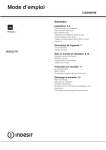
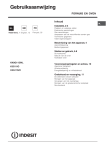
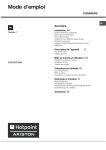
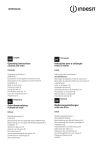
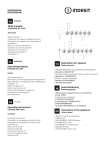
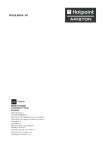

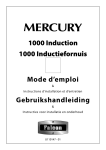
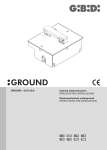
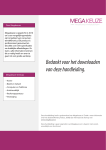
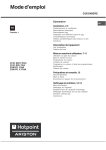

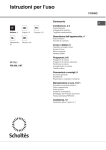
![[fr] Mode d`emploi ..............3](http://vs1.manualzilla.com/store/data/006398960_2-c7556031b398e26c9539303178b00fb6-150x150.png)
